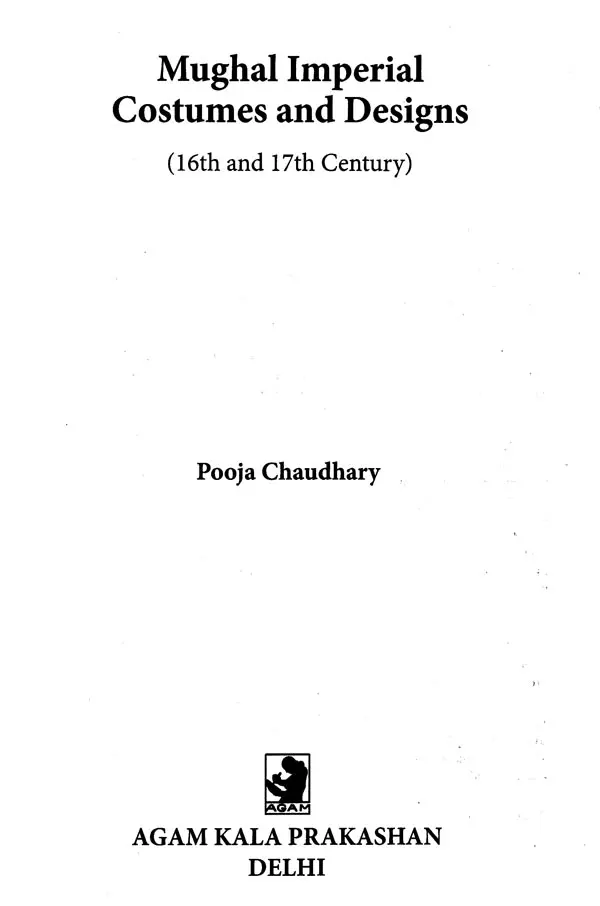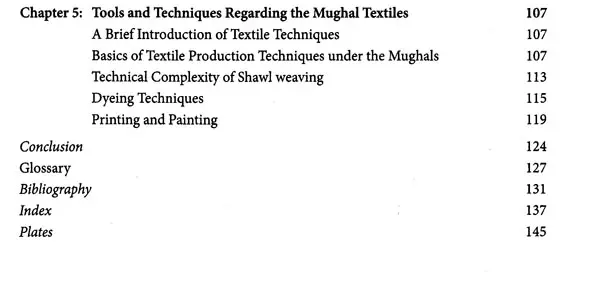
Mughal Imperial Costumes and Designs (16th and 17th Century)
Book Specification
| Item Code: | UAM294 |
| Author: | Pooja Chaudhary |
| Publisher: | Agam Kala Prakashan, Delhi |
| Language: | English |
| Edition: | 2018 |
| ISBN: | 9788173201790 |
| Pages: | 160 (Throughout Color Illustrations) |
| Cover: | HARDCOVER |
| Other Details | 11.00 X 9.00 inch |
| Weight | 830 gm |
Book Description
Present work entitled, Mughal imperial costumes and designs during 16th and 17th century. This work is meant primary for the researcher who want to come in the field of Mughal imperial costumes and designs. It will also prove beneficial for the student of Medieval Indian History.
Unfortunately the primary and secondary sources of Mughal period have not discussed much about Mughal costumes. No separate work exists on this theme. Through several writers have discussed about the costumes of Mughal India but the material we find on Mughal costumes is very scattered. This book covers each and every aspects of costumes and designs of Mughal court either it is dress codes, designs, fabrics, industries, or techniques applied for making the gorgeous costumes of Mughal court.
Here in this work visual evidences are utilized to depict the Mughal costumes and designs. Several types of costumes and designs of Mughal period are continuing even today. So there is an element of continuity in the costumes and designs of the Mughal Period. This is the reason that this work is not only important for the researchers of Mughal Costumes and designs but it will also facilitate those, working in the field of modern costumes and designs.
Dr. Pooja Chaudhary is a Young art Historian with both the practical and theoretical academic background. She did her bachelor's degree in 2005 and passed M.A.(History) in 2007 from Centre of Advanced Study, Dept. of History, Aligarh Muslim University , Aligarh. She did her B.Ed. in 2008 from the dept. of education, Aligarh Muslim University, Aligarh. She has qualified National Eligibility Test (NET) in History in 2012, and it was followed by her Ph.D. degree which she got in 2016 from the Centre of Advanced study, Dept. of History, AMU, Aligarh.
Dr. Pooja is presently working in a college at Mathura. She is a member of 'Indian History Congress', 'Rajasthan History Congress', 'UP History Congress'. She has participated in several conferences and seminars at national level. Dr. Pooja is actively engaged in research work and has visited a number of libraries of India.
Clothing is the basic necessity of mankind along with shelter and food. Costumes are the reflection of one's profession, occupation and social standing. Costumes are also a mark of one's material prosperity. The study of costumes of any people is in fact an endeavour of unfolding the total cultural evolution of that area and its inhabitants. The nature of the costumes of a particular age is determined by several factors i.e. geographical, historical, social, religious, cultural, economic as well as the occupation of the people. The climate conditions of a particular area also play an important role in determining the costumes of a particular race.
The term 'Costume' is derived from the Latin consuetude, which means a complete set of outer garments. Costumes are used not only to cover the body and embellish it; they are also the non-verbal medium of communication and also the reflection of the cultural identity of a person, means to which community or country the person belonged to. The costumes are also the major source to understand the fashion trends prevalent during a particular historical age.
Indian costumes are as varied as the people of India residing on a vast country. Their life style and clothes are described in literature and art. India was invaded several times. Some of the invaders lived in India and ruled for several years and some went away to their homeland. Among them some important were Sakas, Kushans, Scythians, Huns, Turks, and Mughals. This all led to the inter-mingling of their cultural identities with the native people. These multi-cultural influences collectively altered and shaped Indian costumes. This is the reason that India is a hub of the several fairs, festivals and different religious ceremonies. Which inspired the weavers and artisans to create special religious costumes and textiles in India. The special costumes were not only made for religious occasions but for the marriage ceremony also.
When we talk about the Mughals. The cultural renaissance of the Mughal era was an output of the synthesis of Persian and Indian sensibilities that took root around the main centres of power. The Mughal rulers were well known with India's rich artistic heritage and gorgeous textiles and they further contributed to the promotion of the skills of the large population of weavers, dyers, printers, and embroiderers, whose knowledge of finishing the textiles was invaluable. The miniature paintings of the Mughal period are the main sources to know about the exotic costumes and dresses worn by them. These paintings have described the choice of ruling class about how to wear and what to wear. The costumes were also the symbol of their status and hierarchy.
The rich cultural heritage of the Mughals makes a glorious chapter in the history of Indian costumes. A large variety of coats for the men; caps, turbans, skirted gowns, sleeved Jackets and tight breeches for the women were the parts of this cultural heritage. The religion and culture of the Mughals had made a permanent mark on Indian History. The intergrowth of the old and the new forms of costumes and designs resulted in a new style of clothing which paved the way for further reforms in the style of clothing.




















